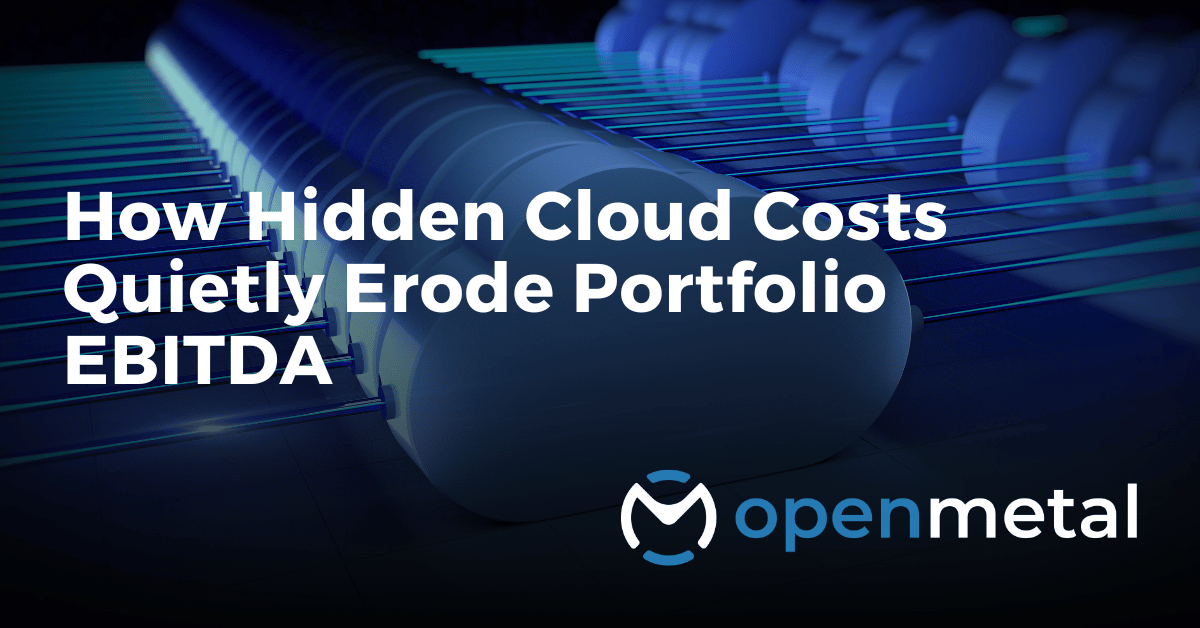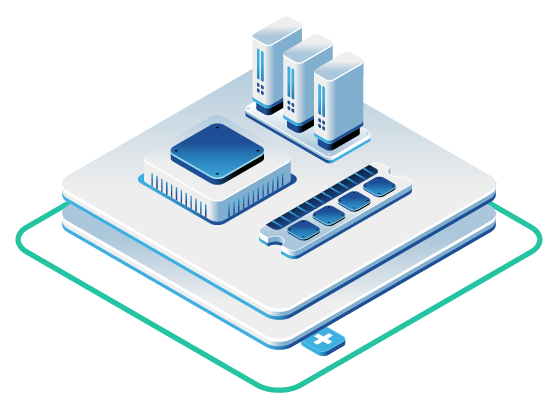
Cloud infrastructure was supposed to deliver efficiency and cost savings. Instead, for many private equity-backed SaaS companies, it’s become a margin-crushing expense that quietly undermines EBITDA targets and portfolio valuations.
The problem isn’t immediately obvious. When your portfolio companies first moved to public cloud, the benefits were clear: instant scalability, no upfront hardware costs, and faster time to market. But as these companies mature, what started as predictable monthly bills have morphed into complex cost structures with surprise charges, usage spikes, and pricing models that punish growth rather than reward it.
Research from Andreessen Horowitz reveals that $100 billion of market value is being lost among the top 50 public software companies due to cloud impact on margins1. For PE firms managing SaaS portfolios, this represents a massive value creation opportunity that’s hiding in plain sight.
The Hidden Mechanics of Cloud Cost Creep
Understanding why cloud costs spiral requires looking beyond the monthly invoices to examine the underlying cost drivers that accumulate over time.
Usage-Based Pricing Unpredictability
Public cloud costs can reach 50% of total cost of revenue for software companies, and the unpredictability makes budgeting nearly impossible. Companies are often conservative when sizing cloud commitments due to fears of overcommitting, which means they pay premium rates for usage above their baseline. Some companies reported that they exceeded their committed cloud spend forecast by at least 2X.
This creates a damaging cycle: teams over-provision resources to avoid performance issues, driving up costs, while usage-based pricing means any growth in customer activity directly impacts infrastructure spend.
Resource Waste in Multi-Tenant Environments
The inefficiency of shared infrastructure becomes apparent when you examine actual resource utilization. In typical public cloud deployments, workloads use roughly 30% of allocated resources on average and burst to use no more than 30% more over time, leaving approximately 40% of VM resources wasted. Yet you still pay for 100% of those allocated resources whether you use them or not.
This waste occurs because public cloud providers optimize for their own economics, not yours. They design instance types and pricing models that maximize their revenue per server, which often means you’re paying for resources your applications can’t effectively use.
The Egress Fee Trap
Data transfer costs represent one of the most insidious hidden expenses. As your SaaS companies grow their customer bases and increase data processing, egress fees compound. These charges are often minimal during initial deployment but can become substantial portions of monthly bills as companies scale.
The challenge is that egress fees are largely invisible during the architecture and budgeting phase. Teams focus on compute and storage costs during planning, but data transfer pricing only becomes apparent after deployment when changing architecture becomes expensive and disruptive.
Instance Type Limitations
Public cloud providers force you to choose from their predetermined configurations, which rarely align with actual workload requirements. Your applications need specific combinations of CPU, memory, and storage, but you’re constrained to pick from what hyperscalers offer, not what your applications actually need.
This often results in over-provisioned infrastructure to handle peak loads that occur infrequently. You’re essentially paying premium prices for resources you need occasionally while leaving other capabilities underutilized.
How OpenMetal Eliminates Hidden Costs
Private equity-backed SaaS companies often face a tough challenge: reduce infrastructure costs without disrupting performance or slowing growth. That’s easier said than done when teams are spread across different platforms or relying on public cloud providers where usage-based pricing and multi-tenant environments make it difficult to predict spend or optimize configurations.
OpenMetal gives portfolio companies the ability to launch dedicated private cloud environments that behave like public cloud — but with fully isolated infrastructure, clear costs, and no long-term commitments. These environments run on dedicated hardware and can be live in less than 45 minutes. Because you’re not sharing resources with other tenants, you’re not affected by noisy neighbors or the limitations of someone else’s architecture. Everything is yours so your team has complete control over how they deploy, scale, and budget.
Predictable Cost Structure
OpenMetal pricing is flat-rate and easy to understand. There are no surprise egress fees or vague licensing costs, and teams aren’t locked into instance types that don’t match their workloads. When your VMs aren’t consuming their full allocation, those resources remain available to your other workloads within the same private environment, eliminating the waste inherent in public cloud resource sharing models.
Right-Sizing for Actual Workloads
Instead of being forced into AWS or Azure’s product catalog, you configure your environment based on how your applications actually behave. If one SaaS company is in growth mode and another is stabilizing, you can provision environments that match their stage — from a Medium V4 with Ceph for smaller, more agile teams to Large or XL configurations for companies running heavier workloads.
You’re not paying for more than you need, and you’re not boxed into less than you can use. This approach typically results in 30-50% cost savings compared to equivalent public cloud deployments.
The EBITDA Impact: Quantifying the Value
The financial impact of infrastructure optimization extends far beyond monthly cost savings. High-growth software companies often trade at 24-25x gross profit multiples, meaning every dollar of gross profit saved through infrastructure optimization translates to $24-25 in market capitalization gains1.
Real-World Savings Examples
Dropbox’s infrastructure optimization initiative saved nearly $75 million over two years by shifting workloads from public cloud to custom-built infrastructure, with gross margins increasing from 33% to 67%1. While not every company will see margins increase by 34 percentage points, the directional impact demonstrates the potential value creation opportunity.
Experts converge on this formula: Repatriation results in one-third to one-half the cost of running equivalent workloads in the cloud1. For PE-backed SaaS companies with significant cloud commitments, this level of cost reduction directly flows to EBITDA improvement.
Portfolio-Level Value Creation
One of the biggest advantages for PE firms is the ability to bring consistency to infrastructure governance across the portfolio. Instead of each company managing cloud costs differently — some overprovisioning out of caution, others stuck in complex hyperscaler pricing models — OpenMetal offers a way to standardize costs, visibility, and performance tracking. You get a repeatable model that helps your portfolio companies align their infrastructure to growth and margin goals, without needing to reinvent the wheel each time.
The compounding effect across a portfolio can be substantial. If multiple portfolio companies are approaching cloud spending levels of 50-75% of cost of revenue, coordinated infrastructure optimization can deliver millions in annual cost savings and tens of millions in increased valuations.
Strategic Implementation for Portfolio Companies
For PE firms looking to reduce cloud spend across a portfolio and increase EBITDA, this flexibility makes infrastructure optimization a strategic priority rather than just a cost management exercise.
Identifying Optimization Candidates
Not every portfolio company benefits equally from private cloud migration. The best candidates typically have:
- Annual cloud spending approaching $1 million or more
- Predictable workload patterns with consistent resource requirements
- Cloud costs representing 50% or more of cost of revenue
- Applications with strict performance or compliance requirements
Timing the Transition
While cloud clearly delivers on its promise early on in a company’s journey, the pressure it puts on margins can start to outweigh the benefits, as a company scales and growth slows. The key is identifying this inflection point before cloud costs become prohibitive to change.
Companies approaching diligence phases particularly benefit from infrastructure cost optimization, as improved gross margins and predictable cost structures enhance valuations during the evaluation process.
Building Migration Strategies
Successful transitions don’t require moving all workloads simultaneously. Production workloads with predictable resource requirements represent the best candidates for initial migration, allowing teams to validate performance and cost savings before expanding the migration.
Data-intensive applications, such as analytics platforms or customer databases, typically see the largest cost savings from private cloud migration since these workloads often trigger significant egress charges in public cloud but operate efficiently within private cloud environments.
Making Infrastructure a First-Class Metric
Companies need to optimize early, often, and, sometimes, also outside the cloud1. This requires treating infrastructure spend as a key performance indicator rather than just an operational expense.
Implementing Cost Tracking
Companies like Spotify have developed internal tools that track cloud spend and enable engineers, not just finance teams, to take ownership of infrastructure costs. For portfolio companies, this means implementing systematic cost monitoring that provides visibility into spending patterns and optimization opportunities.
Creating Incentive Alignment
Some companies offer spot bonuses to engineers who identify and eliminate wasteful resource usage, with reported savings of millions of dollars from these programs. PE operating partners can encourage portfolio companies to implement similar incentive structures that reward cost optimization efforts.
Regular Optimization Reviews
Infrastructure optimization shouldn’t be a one-time project. Regular audits of resource utilization help identify opportunities for further cost reduction, and architectural reviews ensure new developments don’t introduce unnecessary complexity or cost.
The Economics of Scale: When Private Cloud Delivers Maximum Value
Repatriating $100 million of annual public cloud spend typically translates to less than half that amount in total cost of ownership for equivalent private cloud infrastructure. For PE-backed SaaS companies, understanding when this transition makes economic sense becomes crucial for value creation.
Scale Thresholds
The decision point often occurs when cloud spending reaches specific thresholds relative to revenue. Companies spending $100,000+ monthly on public cloud infrastructure typically see immediate cost savings from private cloud migration, while those with smaller workloads may benefit from waiting until scale justifies the transition.
Workload Characteristics
Established SaaS applications with predictable usage patterns benefit most from private cloud’s cost structure. Variable workloads or experimental projects may still warrant public cloud usage, creating hybrid infrastructure strategies that optimize costs across different application types.
Time Horizon Considerations
The ROI on infrastructure optimization improves over time. While public cloud offers advantages for new products and variable workloads, the longer your applications run with predictable patterns, the more compelling private cloud economics become.
Preparing for Value Creation
For private equity operating partners, CFOs, CTOs, and portfolio company infrastructure teams, recognizing infrastructure optimization as a financial engineering opportunity rather than just a technical decision becomes essential for maximizing value creation.
The most effective approach involves early assessment of each portfolio company’s cloud spending trajectory and implementation of cost tracking practices that identify optimization opportunities before they become critical to address.
Given that infrastructure costs directly impact gross margins and, consequently, valuations, the ROI on infrastructure optimization efforts can exceed traditional operational improvements. For PE firms looking to reduce cloud spend across a portfolio and increase EBITDA, this flexibility would be worth it.
Understanding how hidden cloud costs erode EBITDA represents the first step toward reclaiming control over infrastructure spending and unlocking the value trapped in inefficient cloud architectures.
Ready to evaluate private cloud for your SaaS portfolio? Explore how OpenMetal can optimize your portfolio’s infrastructure costs →
[1] Andreessen Horowitz. “The Cost of Cloud: A Trillion Dollar Paradox.“
Read More on the OpenMetal Blog


































